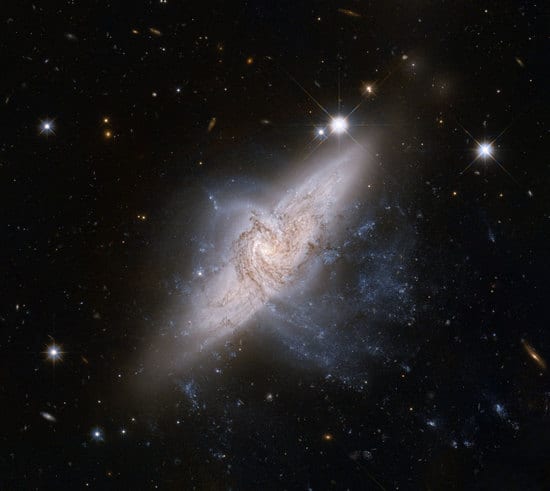Trickster galaxies. (Courtesy: NASA/ESA/ W Keel, University of Alabama)
By Tushna Commissariat
Over the years we have seen some fantastic images of colliding or interacting galaxies. Images of the closely entwined Antenna Galaxies, the Whirlpool Galaxy interacting with its satellite galaxy and the cheesily named Mice galaxies have caught our attention in the past.
So what exactly is special about the image above of two seemingly overlapping galaxies – called NGC 3314 A and B – captured by the Hubble Space Telescope They are a perfect example of “seeing is not always believing”, as the two galaxies are not interacting at all – in fact, they are tens of millions of light-years apart. The only reason that they look like part of a galactic pile-up is thanks to a celestial optical illusion – the two just happen to appear in that configuration from our point of view.
The main clue that led researchers to realize that there was no interplay between the two galaxies was their shapes. When galaxies are interacting, the enormous gravitational force of each galaxy distorts both galaxies out of their normal shapes, long before they even actually collide. These energetic distortions often affect the galaxies themselves, triggering new episodes of star formation that we observe as glowing nebulae.
In the case of NGC 3314, we do indeed see deformation in the foreground galaxy (NGC 3314 A), but this is a bit of a red herring. The distortion that is visible at the lower right of NGC 3314 A’s core, where one can clearly see streams of hot, blue-white stars extending out from the spiral arms, is not caused by any interaction with the background galaxy. Researchers think that the distortion is because of an encounter with another nearby galaxy to NGC 3314 A that can be seen in wide-field images.
Looking at the motion of both NGC 3314 galaxies, researchers say that the two are relatively undisturbed, and are moving independently of each other. This means that the galaxies are not, and indeed have never been, on any collision course.
Such a rare alignment of galaxies is proving useful to astronomers who want to study gravitational microlensing – another type of optical illusion that occurs when the gravitational field of a large astronomical body, such as star or a galaxy, causes small perturbations in the light coming from a more distant source, distorting it. Indeed, the observations of NGC 3314 that led to this image were carried out in order to investigate this phenomenon.
So while it does look very much as if the NGC 3314 galaxies are close-knit, they are nothing more than a chance alignment that gives us an interesting view.




